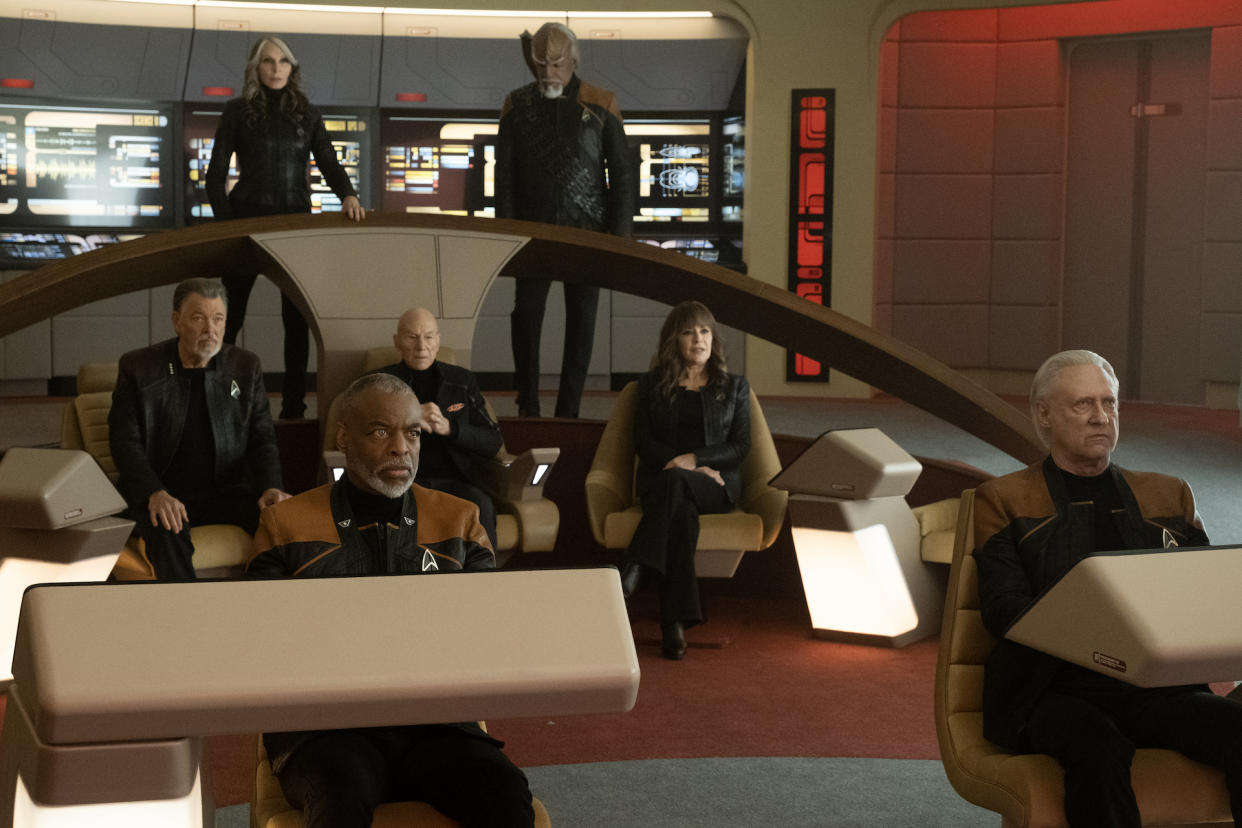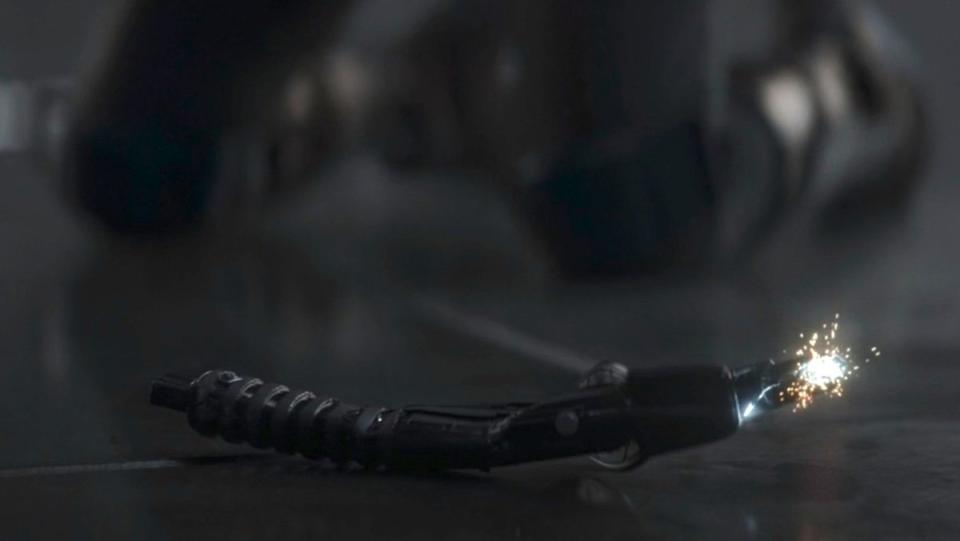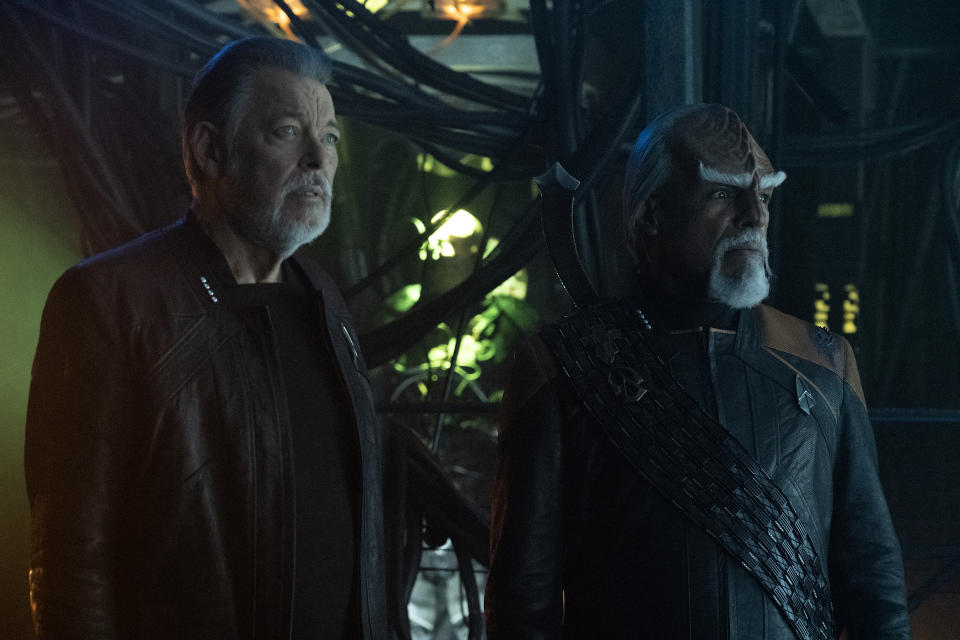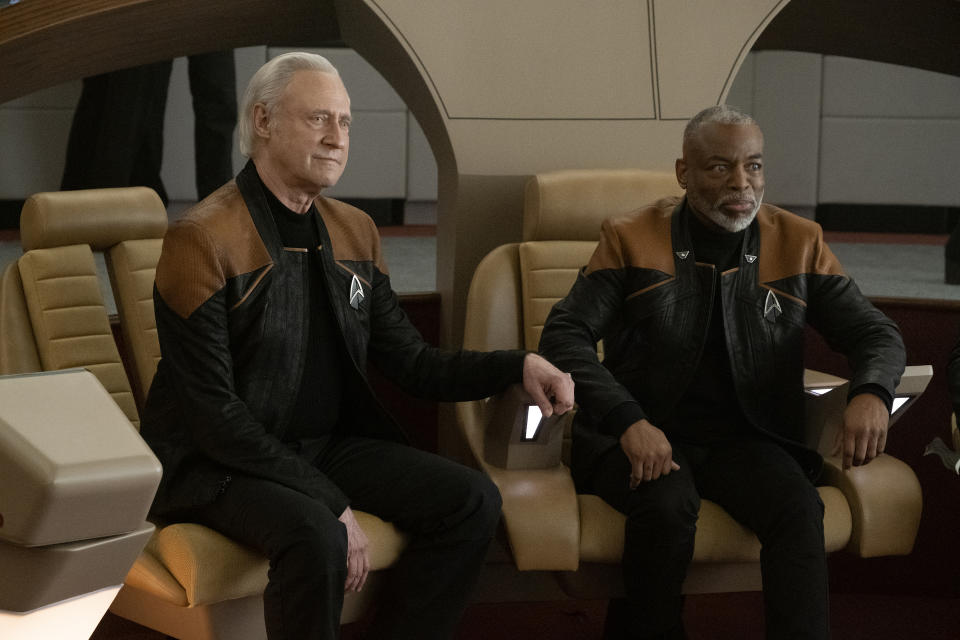‘Star Trek: Picard’ Succeeded in Every Way ‘The Mandalorian’ Failed

- Oops!Something went wrong.Please try again later.
- Oops!Something went wrong.Please try again later.
[Spoiler alert! The below contains extensive details about the finales of both series.]
For the past few years, “Star Wars” definitively had the upper hand over “Star Trek” in the streaming wars. Times change, though: The viewership totals may still be on the side of “Star Wars,” but when it comes to quality there’s no question “Star Trek” has now moved ahead of its rival space franchise.
More from IndieWire
Giancarlo Esposito Couldn't Stop Breaking Lightsabers on the 'Mandalorian' Set
Al Pacino Turned Down Playing Han Solo in 'Star Wars' Because He Couldn't 'Understand' the Script
With the exception of “Andor,” Disney+’s takes on that galaxy far, far away have grown increasingly limp — from the candy-colored nonsense of “The Book of Boba Fett,” to the from nowhere-to-nowhere storytelling of “Obi-Wan Kenobi,” to the astonishingly incoherent Season 3 of “The Mandalorian.” I’ve written before about the creative vacuum that was “Picard” Seasons 1 and 2, but, by any standard, “Star Trek: Discovery” Season 4, the first season of “Strange New Worlds,” and the final season of “Picard” are outclassing everything Lucasfilm is producing that doesn’t star Diego Luna.
This past week, the divergence was particularly striking. “The Mandalorian” Season 3 ended on as stale a note as could be imagined, any hints of evolution or character development flattened into oblivion — this ending also could have been the Season 1 finale, or the series finale altogether, it doesn’t really matter. While “Picard” pulled a bit of a cheat, with a series finale, titled “The Last Generation,” that’s obviously setting up future stories, it was also deeply invested with emotion, found ways of giving meaning to old symbols, and thoughtfully reflected on what the past means rather than just wanting to repeat it. “The Mandalorian” is repetition, “Picard” represented an evolution.
“Picard” Season 3 Invested Old Symbols with New Meaning
A particular moment in the “Mandalorian” finale felt symbolic of the whole thing: The Darksaber, a weapon fraught with meaning for the Mandalorian people as it’s to be wielded by their leader, and has accumulated significance over the course of “The Clone Wars” and “Rebels” animated series before making the jump to live action, was suddenly destroyed. Crumpled in Moff Gideon’s fist like just another toy. Far more disturbing that that moment in “The Last Jedi” when Luke tossed his father’s lightsaber over his shoulder that elicited so many fanboy tears, this act of destruction definitively said that what you’re supposed to care about on “The Mandalorian” is ephemeral and changeable. As did that moment earlier in the season when Pedro Pascal’s Din Djarin just gave it to Katee Sackhoff’s Bo-Katan, even though it’s supposed to be won in combat.
“Star Trek” is not immune to these mistakes either. The 1994 film “Star Trek Generations” had a similar moment when Picard holds a treasured artifact given to him by a beloved mentor (as established on the episode “The Chase” of “The Next Generation”) then casually discards it among the wreckage of the Enterprise-D. That mentor was legendary actor Norman Lloyd, no less! And this thing that had been invested with meaning suddenly had none. The Darksaber is basically given that same treatment on “The Mandalorian.”

On the other hand, “Picard” Season 3 goes on to show that LeVar Burton’s Geordi LaForge actually recovered the saucer section of the Enterprise-D from its crash in that previous film and spent 20 years restoring the ship to its old glory. The fact that it was older and unplugged from Starfleet’s new “Fleet Formation” ship-linking system meant that it wasn’t assimilated by the Borg. This was a bit of a ripoff of how the title ship on Ronald D. Moore’s “Battlestar Galactica” series survived because it wasn’t part of an internet-like network as well, but still a potent metaphor for how you can look to the past to find solutions for the present.
Likewise, “Picard” Season 3 spent an entire season building the USS Titan as a ship to revere. Rechristening it the new USS Enterprise NCC-1701-G was another example of taking something old… and evolving it. Basically the approach of this entire final season.
“Picard” Season 3 Showed Real Evolution of Its Characters
How is Mando any different at the end of Season 3 than he is at the end of Season 1? On the other hand, the “Next Gen” characters brought back for “Picard” have evolved strikingly. Gates McFadden’s Beverly Crusher is now capable of being a helluva tactical officer for the Enterprise. Jonathan Frakes’ Riker and Marina Sirtis’s Troi draw strength from their relationship rather than the “will they? won’t they?” waffling they engaged in for seven years on “Next Gen.” Brent Spiner’s Data is finally a “real boy,” a flesh and blood human (more or less) his consciousness was downloaded into — he experienced death, now he needs to face aging. Michael Dorn’s Worf is a warrior for pacifism now. Geordi is a father of two grown daughters and far from the tremulous guy he could once be when it came to relationships.
And for Picard himself, the most interesting thing is to consider how Patrick Stewart’s acting style has evolved since “Next Gen,” where he could be a stern authoritarian figure telling Data, when the android was cosplaying as Sherlock Holmes, to “lose the damn pipe.” By “First Contact,” Picard had basically become one of Hollywood’s bald badasses, rocking a tank top Bruce Willis-style to defeat the Borg Queen in gruesome fashion. Now, he’s a lovable old softie, sanded down by time, an avatar for cute. If “Picard” has a Baby Yoda, it’s Picard himself.
“Picard” Season 3 Also Evolved the Meaning of the Greatest “Trek” Villains, the Borg
“Picard” Season 3 also gave a whole new subtext of meaning to the Borg. When introduced in the late ’80s, they represented the ultimate nemesis to Gene Roddenberry’s much-touted mantra of “infinite diversity in infinite combinations.” The cybernetic baddies were a homogeneity that subsumes anything unique into its monolithic whole. They represent a world where everyone can communicate, yes, but everyone speaks just one language and there’s no diversity of any kind at all. That makes them the ultimate “Star Trek” villains.
But in Season 3 we’re reintroduced to the surviving Borg, last seen in the finale of “Star Trek: Voyager” in 2001 when Janeway kills most of them, and we see it’s mostly just the disfigured Queen (hauntingly voiced once again by Alice Krige) and a few scattered drones. She herself consumed most of her collective to keep herself alive. And the only way to grow is “by taking over someone else’s army,” finding a way to automatically assimilate everyone in Starfleet who’s 25 years old or younger. (25 being the age at which our brains stop developing.)

Paramount+
The Borg thus become a very 21st century metaphor for the conformity young people are encouraged to contribute to on social media: looking a certain way, acting a certain way, having fun a certain way, being #blessed. FOMO is the ultimate driver toward a collective mindset. Picard says to his son Jack (Ed Speelers), who’s been assimilated into the Borg that he gets it, that feeling of being “hungry to connect while needing to keep people distant so they never see the real you.” The Borg are all connected. They’re never alone. But as just one voice aggregated out of many, and performing only a version of themselves, they’re essentially anonymous too.
To the credit of “The Mandalorian,” it does seem to be trying to evolve our notion of the Empire as well, turning someone like Giancarlo Esposito’s Moff Gideon into someone only obsessed with survival. And to do so he’ll take the best attributes of his enemies (the Beskar armor from the Mandalorians, the Force from the Jedi) and put them all into a new clone body he’ll download himself into. He’s basically looking to assimilate his enemies as much as annihilate them. Yet all of this conveyed without much emotional resonance.
“Picard” Season 3 Created a Real Sense of Atmosphere and Stakes
From the moment that sitar plays Jerry Goldsmith’s Borg theme from “First Contact” to open the finale episode, you know, if it hadn’t already been apparent, that an extraordinary attention to detail is going to follow. Having Walter Koenig voice Anton, the son of Pavel Chekhov, who’s apparently the current Federation president, helps hearken back to an even earlier generation to give additional heft to what might be lost with Earth under assault.
Fantastic images abound in this finale episode, “The Last Generation.” A giant Borg cube sitting in the swirling red dot of Jupiter, poking out like the rocket that lands in the moon’s eye in “A Trip to the Moon.” The acting too: the robotic, ramrod-straight way Ashlei Sharpe Chestnut walks to convey she’s been assimilated. It all creates a powerful effect, a story told through images and gestures that’s full of special effects “Next Gen” couldn’t have dreamed of employing in its original run but built on the most foundational elements of visual storytelling.

Paramount+
By contrast, Mandalore is so underdeveloped as a place in “The Mandalorian,” that the title character decides not to even live there after winning it back for his people. Its history is skimped on in every conceivable way, down to the bizarre decision never to mention the character of Duchess Satine Kryze, Bo-Katan’s sister, who was a major part of the animated shows “The Mandalorian” is built on.
“Picard” Season 3 Also Recognizes There’s an Element of “Playing with Toys” to This Story
And has some major fun with that. The very idea of the Borg forging an alliance with what’s left of the Dominion (the villains from “Deep Space Nine”) is the kind of thing a 12-year-old in 1998 would have dreamed of. Not to mention that the assimilated Starfleet’s assault on Spacedock looks very much like the battles you could wage against Spacedock in the mid-90s computer game “Birth of the Federation.” Or that the Borg control a whole fleet of assimilated Starfleet ships, just like you could do in the “Star Trek: Armada” game. The references and the images here feel deep and organic and sprung out of a shared imagination about what made ’90s “Trek” unforgettable.
On the other hand, the masked-warrior versus masked-warrior showdown on “The Mandalorian” finale felt like the way “Community” made fun of “Blade” as just endless metal-on-metal clanging. “Star Wars” is not supposed to be quite that loud. And somehow, despite all that noise, “Picard” still delivered the superior space battles — an area where “Trek” was usually inferior to “Star Wars.”
To sum up:
In every way that matters, “Picard” had the edge over “The Mandalorian” this season. And in the age-old “Star Trek” versus “Star Wars” debate, both franchises are living long but only one is prospering right now.
Best of IndieWire
Sign up for Indiewire's Newsletter. For the latest news, follow us on Facebook, Twitter, and Instagram.

